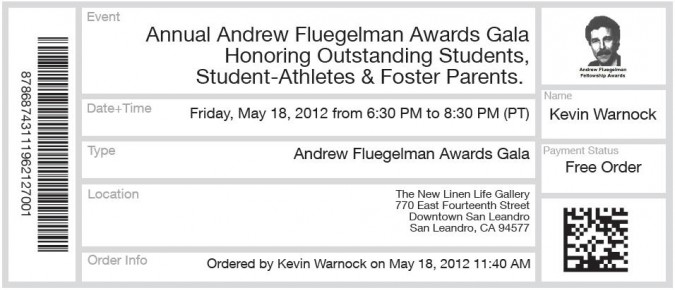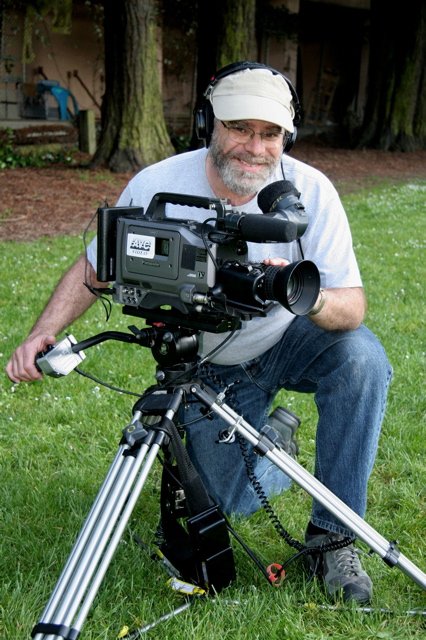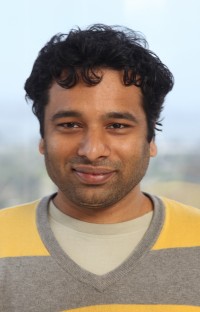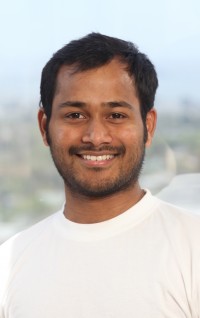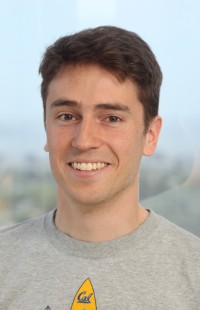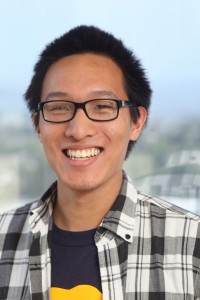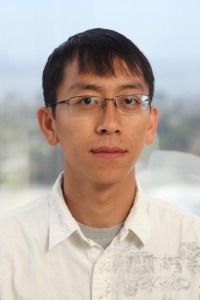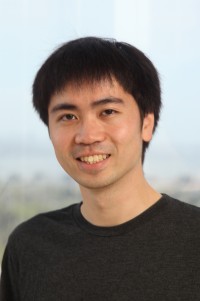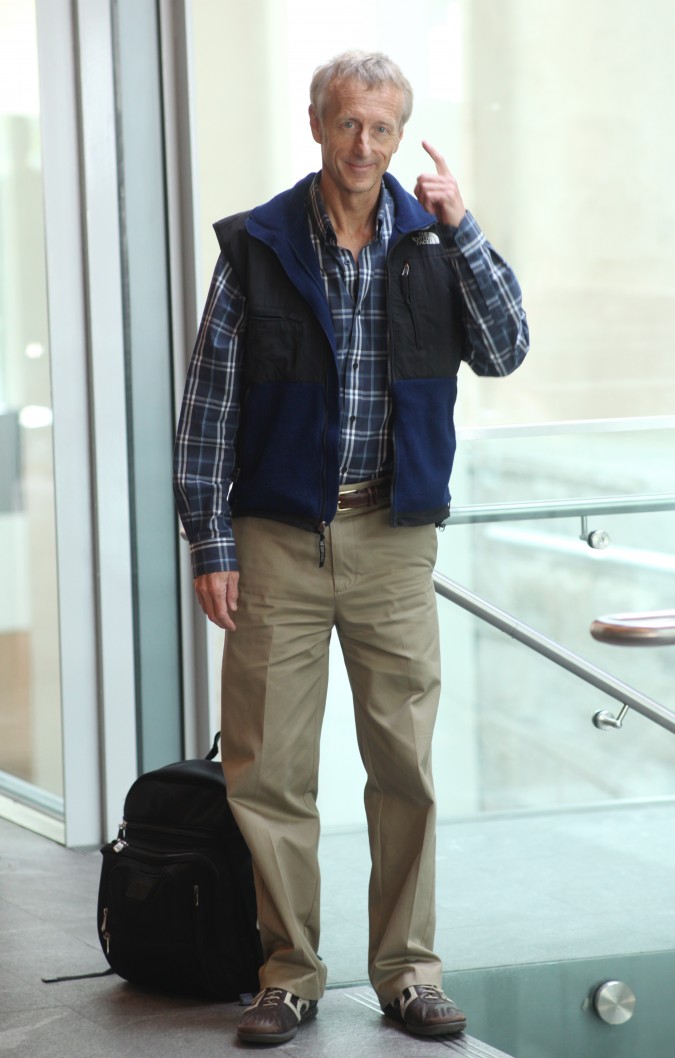Archive for May, 2012
University of California Berkeley student Henry Treadway died May 8, 2012

Henry Treadway vigil, May 11, 2012, UC Berkeley campus, photo by Anda Chu of the San Jose Mercury News
University of California Berkeley student Henry Treadway died May 8, 2012. The death is being investigated as a suicide. Apparently, Treadway fell from a window in the dormitory building where he lived.
Treadway was a sophomore. He touched a lot of people. The Facebook page set up to invite people to attend a memorial vigil for Treadway gathered over 3,957 RSVPs out of 3,992 invited, as you can see in the Facebook screenshot I captured and have included below.
It’s always sad when someone takes their own life, especially when the person is smart, productive and well liked.
This is the second suicide that I’ve learned of in two days. I didn’t know either of the individuals, but both made me reflect on the subject of suicide.
I learned about Treadway’s death on Facebook via a Wall posting by my friend Cindy Lu. I met Lu last year when she helped organize the inaugural startup pitch competition Made for China.
I have been very close with someone who has told me that in the past they have considered suicide. This person is also smart, productive and well liked, and although I am no longer in touch with them, it would shatter my heart if I were to learn that they took their own life. It would probably take me years to fully recover, for I would wonder if I should have told anyone what I knew, while there would have perhaps been time to do something to prevent it.
I do not know who reads this blog, for the most part. I do not know if the friends and family of the person I am writing about above read this blog. Since I don’t know, I am not disclosing even the gender of the person, to protect their identity. What I know is sensitive, and while I did not promise discretion to this person, I feel that they assumed I would be discrete, and that they want me to continue to be discrete, indefinitely.
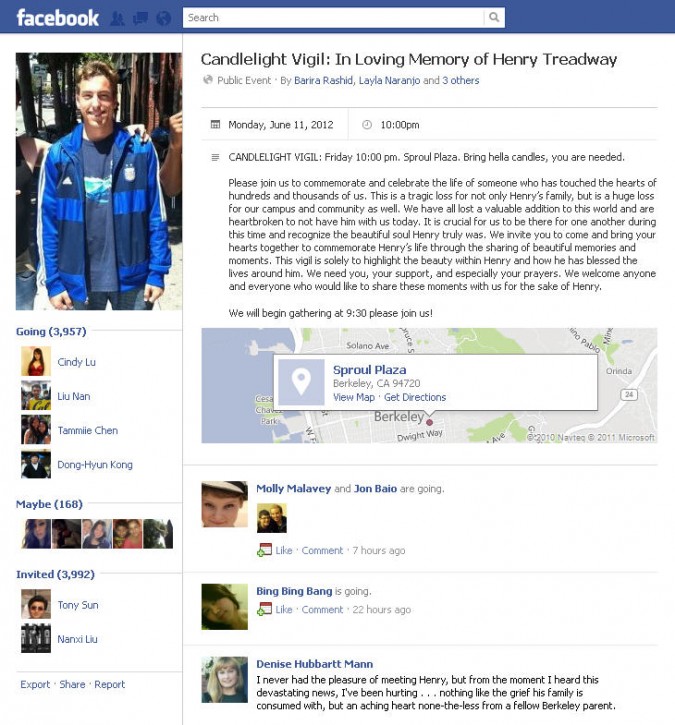
Henry Treadway Facebook candlelight vigil invite. Screenshot from Facebook, May 19, 2012 at 7:40PM PT.
If the person I write about is reading this, please do not take your own life! Despite our distance, I still care for you, and I know many others do as well. Everything you consider broken can be fixed — even the things that are broken that you don’t know are broken can be fixed. Life is worth living. Life is to be cherished and celebrated.
Do not assume you know who I am writing about. It could be any of hundreds of people that I have cared about over my lifetime. But if you’ve considered taking your own life, even if you don’t know me, you are welcome to think I am writing about you in particular.
The other person that I just learned apparently took their own life is Andrew Fluegelman. Fluegelman disappeared in 1986, and it’s presumed he killed himself by jumping off the Golden Gate Bridge, although his body was never located. I wrote a blog post on May 20, 2012 about Flugelman because I attended May 18, 2012 the Annual Andrew Fluegelman Awards Gala honoring outstanding students, student-athletes & foster parents. This was a moving event, and I am friends with Stuart Sweetow, a videographer that made the May 18th Gala particularly special. Read the post for details.
Here are some more links to stories about Henry Treadway:
Henry Treadway aka sfkicks Gone Far Too Soon – Rest in peace
Hundreds Mourn El Cerrito Native at UC Berkeley Vigil
Student Falls From Unit 2 Dorm Window
Twitter.com Tweets about Henry Treadway
Friends and Family Remember Henry Treadway, UC Berkeley Sophomore
Vigil For UC Berkeley Sophomore
I extend my sympathies to the friends and family of Henry Treadway. From what I learned preparing this post, Henry was deeply loved and appreciated by those around him. May his memory remain bright in your hearts and minds. If an investigation concludes his death was not self inflicted, then I pray those responsible will soon be brought to justice. No matter the cause of death, Henry’s memory will endure.
Annual Andrew Fluegelman Awards Gala Honoring Outstanding Students, Student-Athletes & Foster Parents, May 18, 2012
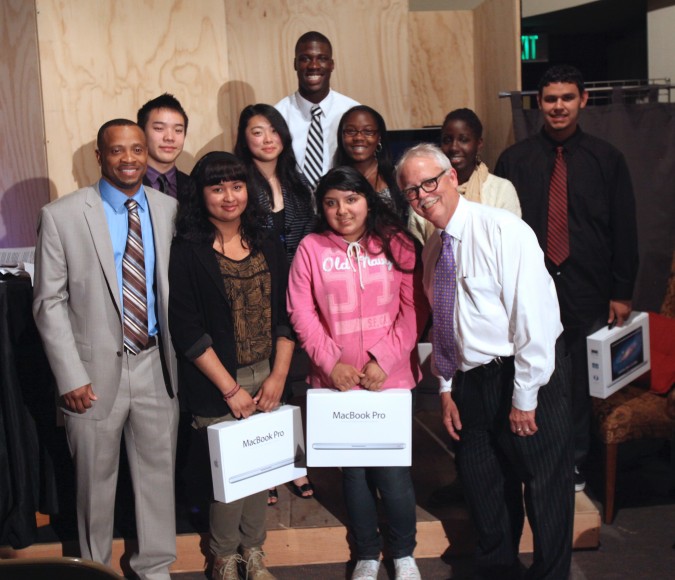
Winners of 2012 Andrew Fluegelman Foundation Fellowship Awards showing off their new Apple MacBook Pro laptop computers, May 18, 2012. Bruce Bouligny on left and David Bunnell in white shirt.
On Friday, May 18, 2012, the day of the Facebook Initial Public Offering of stock, I attended the annual Andrew Fluegelman Foundation Fellowship Awards Gala, held at the Linen Life Gallery at 770 East 14th Street, San Leandro, California USA. Here is the Facebook page for the Andrew Fluegelman Foundation. Bruce Bouligny is the Director of the Fluegelman Foundation.
I learned of this event the morning of the event, thanks to a Facebook status update from Harry McCracken, Editor-at-large at Time Magazine. McCracken encouraged his Facebook subscribers, of which I am one, to attend this event. McCracken also linked to a piece he wrote for Time entitled Remembering Andrew Fluegelman, a Quiet Giant of the PC Revolution that introduced me to Andrew Fluegelman, a man I had not previously heard of. Once I read McCracken’s piece on Fluegelman, I got a ticket for the Awards Gala and attended as a blogger. Amazingly, the tickets were free, although they did ask for a modest donation at the door, which I happily made.
Andrew Fluegelman disappeared in 1986, and it’s assumed he committed suicide by jumping from the Golden Gate Bridge. He was 42, and his body was never found.
I had only been at the Linen Life Gallery for mere minutes when my friend Stuart Sweetow came over to say hello. I recognized him but couldn’t place him, as I only see Sweetow at the Berkeley Entrepreneurs Forum at The Lester Center for Entrepreneurship and Innovation at the Haas School of Business at the University of California at Berkeley. He’s the videographer for the forums, and has been for some 15 years. I have had the privilege of appearing in one of Sweetow’s videos that he created for the Forum.
Sweetow absolutely made my evening.
How so? It turns out that Sweetow runs a business called Audio Visual Consultants. He’s been in business since 1983 — impressive. In 1986 he was hired by PC World, which Fluegelman co-founded with David Bunnell, to produce a video tribute to Andrew Fluegelman.
A few weeks ago, Sweetow was moving his company’s office and studio to new space and he stumbled upon the ancient video cassette he had produced decades earlier. He decided to call David Bunnell, the co-founder of the Andrew Fluegelman Foundation (and PC World Magazine), to ask if he wanted the tape. Bunnell was probably stunned to get Sweetow’s call. The copy PC World received decades ago had been lost. It was thought that it would never resurface. Thanks to Sweetow, the Foundation and presumably PC World has the video again, and it’s been posted to YouTube so a wider audience can view it.
What a heartwarming story. Here’s Sweetow’s video:
I asked Sweetow if I could blog about this story, and he said that I may.
Sweetow then pointed out that David Bunnell was standing near us. Sweetow offered to introduce me, and I accepted.
David Bunnell co-founded PC World Magazine with Andrew Fluegelman. I used to read PC World frequently. Before the Internet, such magazines were required reading for those interested in technology. You read such magazines the way we read websites like TechCrunch and Engadget today. I got to meet a publishing legend Friday night.
Happily, PC World is still in business, with a vibrant online presence in addition to the physical editions of the magazine.
I asked David Bunnell if I could photograph him, and not only did he agree, but volunteered to step outside into the still bright daylight so I could get a well lit portrait of him. Had he not volunteered, I would have directed him outside, as the light there was perfect. The pictures of Bunnell are at the bottom of this post.
I used my Canon 5D Mark II for these photographs, and I uploaded them at full 21 megapixel resolution. Click on the pictures to see them at full size.
Here is what David Bunnell wrote for the official paper program distributed at the event:
“Andrew Fluegelman (1942-1985)
During his brief life, Andrew made major contributions to the booming computer revolution. In addition to co-founding PC World and Macworld magazines, he wrote PC-Talk, the software program that for the first time made it possible for personal computers to exchange data over a phone line.
Believing that PC-Talk should be available to as many people as possible, Andrew came up with the novel idea of simply giving it away and asking people to send in a donation if they liked the program.
Andrew called this method of distributing software, “freeware.” Thousands of other programmers started making their software available this way, which helped the PC industry grow even faster.
Underlying Andrew’s work was his profound belief that personal computers have the power to transform anyone’s life. Whatever a person’s background and circumstance, if they had a computer their lives could be dramatically changed for the better.
With the help of some of Andrew’s other friends, I established the Andrew Fluegelman Foundation to keep his memory alive and to realize his vision that computers can make a dramatic difference.
Working with other nonprofit organizations, we identify outstanding high school seniors who have overcome the challenges of growing up in poor neighborhoods and who have been accepted into university, college or other advanced educational program. They also must demonstrate a desire to “give back” to their communities.
In Andrew’s name, we give these students a Macintosh laptop computer, printer and training in the use of Google applications, courtesy of Google.
So far, all the students who have won Fluegelman Fellowships have gone on to be successful in college. They arepot to us that owning their own Macintosh computers has been a huge part of that success.
I truly believe Andrew would have loved this program, and that his spirit is with us tonight.
–David Bunnell”
Fluegelman in 1982 created PC-Talk, the first dialup communications program for IBM Personal Computers and their clones. Back then, computers were connected via standard wired telephones directly to each other, not by going through central servers run by companies like AOL, Compuserve or Prodigy. Fluegelman distributed PC-Talk at no charge, and encouraged people to copy it and give it to friends. He made money by asking but not requiring that people mail him money via postal mail. He suggested donations of USD $25 and later more. That was a fair amount of money back then. I suspect it still works today, at least on Windows XP.
Fluegelman was the first Editor-in-Chief of PC World magazine. He interviewed Bill Gates in 1984, as shown in this picture from the Fluegelman Foundation’s Facebook page:

Andrew Fluegelman, on the far right, interviewing Bill Gates, standing, in 1984. Photographer unknown.
The Fluegelman Foundation honors Andrew Fluegelman’s memory by awarding Apple MacBook Pro computers to seven deserving high school seniors each year. Fluegelman believed that a computer could change a person’s life, so he would have approved of the work this foundation is doing.
This year Apple MacBooks were awarded to:
- Daniel Rodriguez – Castlemont High School
- Teresa Unique Cole – MetWest High School
- Andranee Nabors – Berkeley High School
- Cara He – Skyline High School
- Rocio Montes – Skyline High School
- Brian Lien – Skyline High School
David Bunnell and Bruce Bouligny took turns reading portions of the winning essays these winners submitted to compete for the laptops. The students were not given a chance at the microphone to say ‘thank you.’ I suspect this was the first time these students had been on stage outside of school. In future years, I suggest the organizers allow each student 60 seconds at the microphone to say thank you. They should be told of this opportunity in advance so they can prepare and practice their remarks. They will likely be nervous, but it should be a condition of winning that they say something. It will be a valuable learning experience to speak before strangers, and it’s one they won’t likely ever forget. The audience I am sure would welcome hearing from the students.
I tried hard to get permission to photograph the winners individually like I was able to photograph David Bunnell and Larry Magid, below. But I didn’t ask soon enough and the time simply ran out. I would have loved the chance to spend two minutes with each student properly photographing them. If I attend next year, I will prepare in advance with the organizers so that I can do this.
The Fluegelman Foundation also gives awards to an outstanding foster parent each year. I did not learn how this award is connected to Fluegelman, and there may be no overt connection. Whether there is or not isn’t important. The evening was an inspiring delight, and I am so glad that I attended.
Two foster parents spoke.
The first foster parent to speak was Tracy Beckham, who has 12 children. Eleven she and her husband adopted after doctors told her they would not be able to conceive and carry to term a biological child. We learned that their youngest child, the girl in the white dress below, is their biological child, and she was conceived naturally with no assistance from the fertility industry. Beckham told us how doctors at first thought she was sick, but eventually concluded she was pregnant. What a happy surprise.

Tracy Beckham with her family plus a few others, May 18, 2012 at Andrew Fluegelman Fellowship Awards Gala. Photo by Kevin Warnock.
Beckham’s 6’6″ son Dorial Green-Beckham, the tallest in the two shots immediately above and below, is already famous, with his own entry in WikiPediA, I learned. The pictures I took of him are likely to get this blog some significant traffic. Thank you Dorial and thank you to his mother Tracy, who gave me permission.
Dorial is a famous high school football player. According to The Columbian Missourian newspaper, Dorian was the most recruited high school football player in the United States in 2012. Here’s a long piece that details how intense this process was.
Dorial signed with the Missouri Mizzou Tigers, after a courtship that lasted years. I had no idea before today that even happened. I don’t follow football, and I only occasionally watch the Super Bowl.
I had never heard of Dorial before this event. I am glad that I met him, and he was gracious and patient as I set up the pictures you see here. I gave him posing directions just like I give the female models I photograph. I wonder what he thought of me given that he’s probably been photographed by hundreds and hundreds of photographers to date.
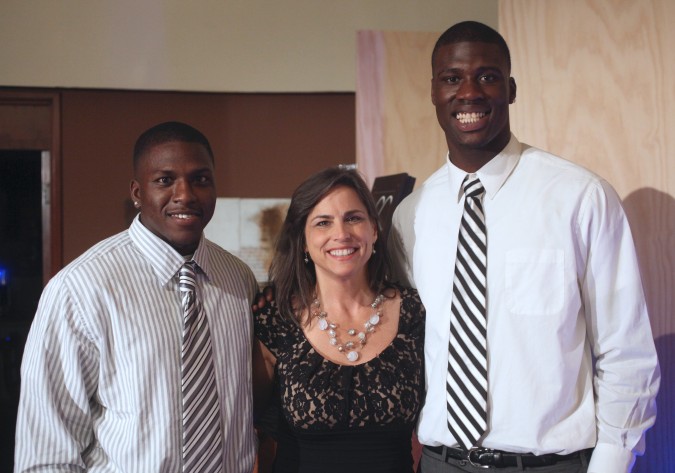
Tracy Beckham with 2 of her 12 children including Dorial Green-Beckham on the right. May 18, 2012 in San Leandro, California. Photo by Kevin Warnock.
Have a look at this YouTube video that shows Dorial breaking the United States national receiving record for high school football.
Here’s a clip of Dorial catching a 79 yard pass with one hand during the 2012 Army All American Game. Looks impressive to me:
Dorial Green-Beckham was awarded the first National Fellowship awarded by the Fluegelman Foundation, and Dorian was given an opportunity to speak to the audience, which he accepted.
The second foster parent to speak was Athaline Burns, shown in the photograph below holding her award plaque for East Bay Foster Parent of the Year.
Burns told the crowd she provided care to about 100 foster children that lived in her home over the years. This is an astonishing and important contribution to society. Burns kept her remarks short, so I don’t have any stories to relate about her remarkable life. I didn’t have the opportunity to talk with her after the event, which I regret. I would like to interview her for this blog at some point, and meet her family to hear about their experiences first hand. I have at times considered becoming a foster parent, so I have more than a casual interest in this subject.
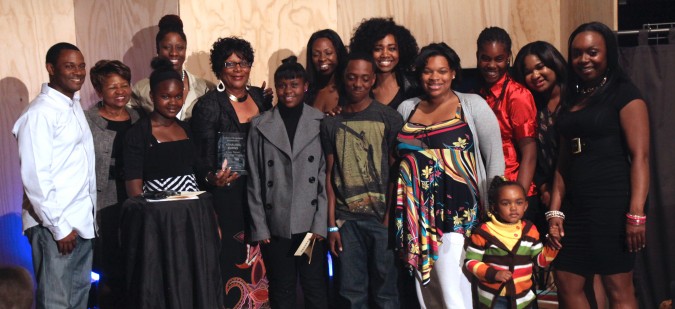
Athaline Burns, holding award plaque, shown with her family. Burns is East Bay Foster Parent of the Year. May 18, 2012 in San Leandro, California. Photograph by Kevin Warnock.
Here is the portrait that I took of David Bunnell and Larry Magid together:
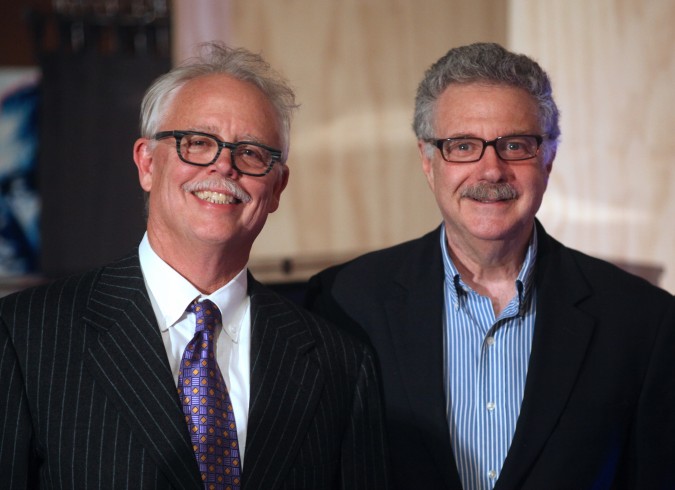
David Bunnell and Larry Magid, May 18, 2012 at Andrew Fluegelman Foundation Fellowship Awards Gala in San Leandro, California. Photo by Kevin Warnock.
Bunnell and Magid provided commentary at the start of the event about the storied life of Andrew Fluegelman. I got the distinct impression that both Bunnell and Magid are elder statesmen in the technology industry, so I am so grateful that I got to photograph them together and separately, and that the results were so pleasing. Magid asked if he could use the results, and I happily told him that he may. Of course, Bunnell may as well, as well as all the others that I photographed. I am very flattered when I encounter my photographs around the web and on other peoples’ Facebook pages. Twenty four of my Facebook friends are also friends with Magid.
Larry Magid is Co-Director of ConnectSafely, a non-profit. Magid provided Gala attendees with free copies of the book A Parent’s Guide to Facebook (also published in Arabic). I have a copy, and from reading part of it I can say it’s well written and likely to be very valuable to parents. I’ve never seen such a lushly produced guide to safely using potentially a potentially dangerous site like Facebook. I plan to read the entire book. Here’s an abstract of what ConnectSafely is about, from the group’s website:
“ConnectSafely is for parents, teens, educators, advocates – everyone engaged in and interested in the impact of the social Web. The user-driven, all-media, multi-platform, fixed and mobile social Web is a big part of young people’s lives, and this is the central space – linked to from social networks across the Web – for learning about safe, civil use of Web 2.0 together. Our forum is also designed to give teens and parents a voice in the public discussion about youth online safety begun back in the ’90s. ConnectSafely also has all kinds of social-media safety tips for teens and parents, the latest youth-tech news, and many other resources.
ConnectSafely.org is a project of Tech Parenting Group, a 501(c)3 nonprofit organization based in Palo Alto, Calif., and Salt Lake City, Utah. The forum is co-directed by Larry Magid of SafeKids.com and Anne Collier of NetFamilyNews.org, co-authors of MySpace Unraveled: What It Is and How to Use It Safely. (Peachpit Press, Berkeley, Calif., July 2006).”
Larry Magid is also the on-air technology analyst for CBS. Magid has over 62,000 subscribers on Facebook.
Here is the portrait that I took of David Bunnell:
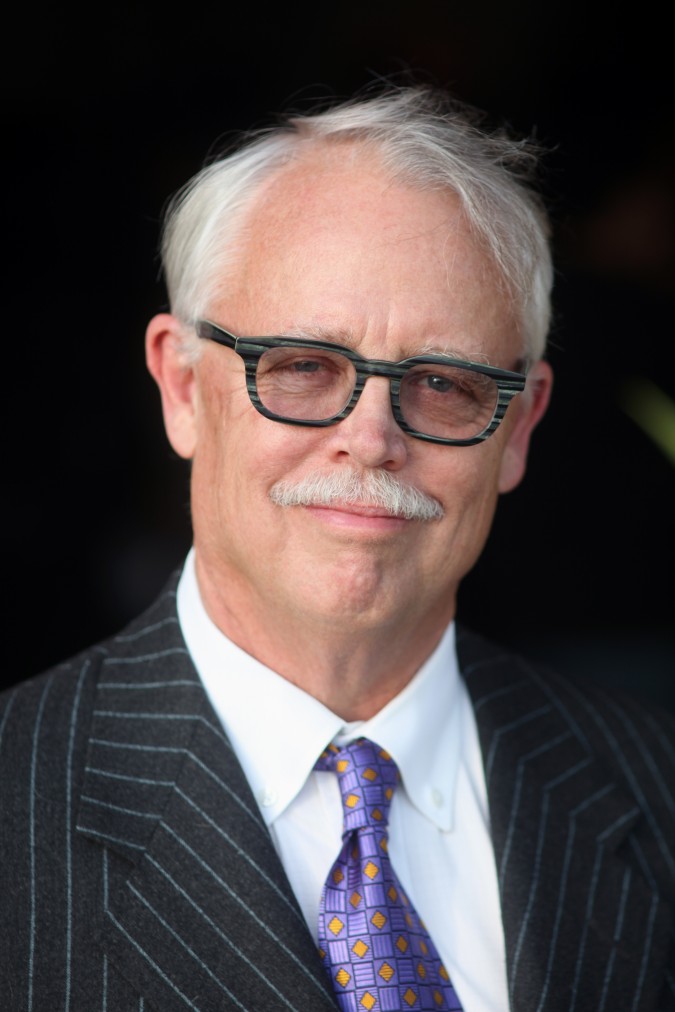
David Bunnell, co-founder of Andrew Fluegelman Foundation, May 18, 2012. Photographed by Kevin Warnock.
Here is the portrait that I took of Larry Magid:

Larry Magid, on-air technology analyst for CBS, photographed May 18, 2012 at the Andrew Fluegelman Foundation Fellowship Awards Gala. Photo by Kevin Warnock.
Here is a photograph of the reception prior to the awards ceremony. The food and drink were outstanding, thanks to B Restaurant and Bar, Trader Joe’s, Markham Vineyards, Carl Talaue Catering, RSVP Catering and T-Rex BBQ.
The Skyline Jazz Band, made of up musicians from Skyline High School, played during the reception. The band’s director is Vincent Tolliver. The musicians are:
- Olivia Ports – Drums
- Ella Pearson – Piano
- David McMillan – Guitar
- Zach Seidl – Bass
- Jeff Seidl – Trombone
- Jeramy Kaetzel – Trumpet
- Andrew Wong-Rolle – Alto Saxiphone
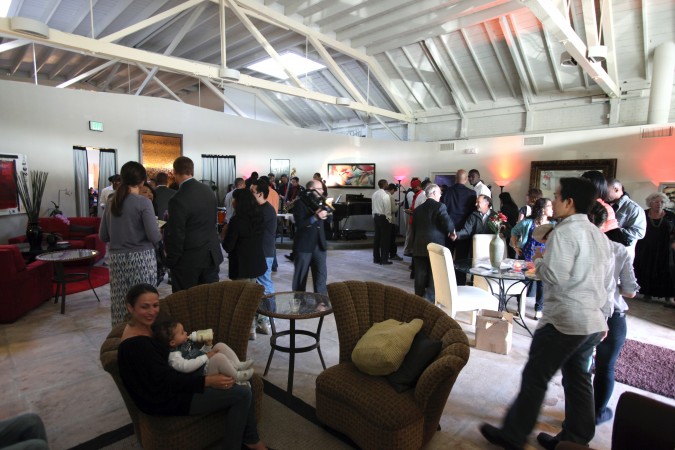
Reception at 2012 Andrew Fluegelman Foundation Awards Gala in San Leandro, California, May 18, 2012. That's Stuart Sweetow in the center holding the video camera.
Charleston Pierce was the Master of Ceremony. I found him vibrant, charismatic and engaging. He said he’s a graduate of San Francisco School of the Arts, or SOTA. This school is located in the same building where I went to high school. That school, J. Eugene McAteer High School, was dissolved in 2002 due to its being atrocious, which I can personally confirm.
SOTA seems to be churning out winners, like Devon Ivie, Havel Weidner and Cristina Rey, all of whom I met in February, 2012 at the San Francisco Mock Trials citywide finals. They were on the student team representing SOTA, which this year competed with Lowell High School, generally thought to be the best public high school in San Francisco. SOTA lost to Lowell this year, but has won over Lowell multiple times in past years. The students I met in February are very polished and impressive, and I predict they will go far in life, unlike most of my McAteer classmates, I am sad to report.
I got to shake Pierce’s hand, but sadly didn’t get to interview him. He’s in the entertainment industry, and I bet he’s somebody my readers would love to learn more about. If he’s reading this, I invite him to contact me to schedule an interview.
Congratulations to all the winners at the 2012 Andrew Fluegelman Foundation Fellowship Awards. To the student winners, I say study hard in college, drink alcohol very moderately or not at all, decline all illegal substances and activities, keep in touch with your professors long after you graduate, and start building and nurturing your personal brand right now, by blogging and Tweeting thoughtfully, articulately and responsibly.
When you graduate, future employers will then have four years (decline the five year program!!!) of your posts to read to get a sense of who you are and why they should hire you. You’ll be far ahead of most of your peers, even your peers that might have better academic credentials than you have earned. In life it’s not just grades, but your character, passion and drive that will advance you past your peers. You can start today with WordPress and your shiny new Macbooks. Good luck, and drop me a line once a year to let me know how your MacBook enhanced lives are going. I will write about you here if you take me up on this.
College will be over in two snaps of your fingers, so relish it, embrace it and blog about it! Have fun.
———-
May 21, 2012 – I added a photo credit to the caption under photograph of Stuart Sweetow, which was taken by Rufus Diamant.
I meet the Picatcha.com team at the University of California Berkeley Skydeck startup accelerator
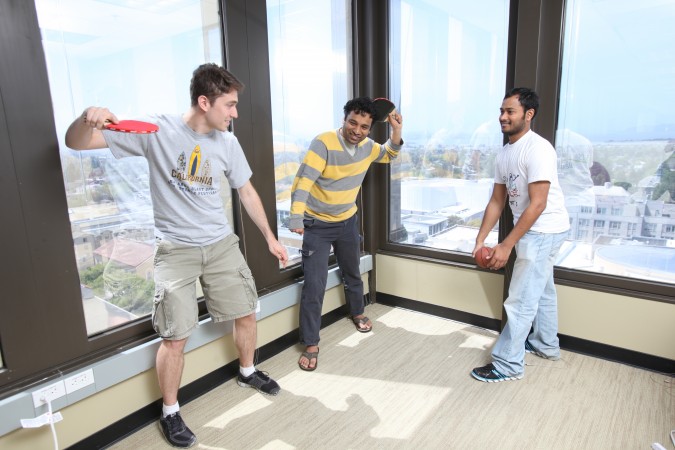
Picatcha.com team playing ping pong with a basketball. May 2, 2012, at University of California Berkeley Skydeck startup accelerator. Photograph by Kevin Warnock.
On May 2, 2012 I met with Satish Polisetti, Dhawal Mujumdar and Sean Carey of Picatcha.
Picatcha is a made up word combining ‘picture’ and ‘Captcha.’
Captcha stands for Computer Automated Public Turing Test to tell Computers and Humans Apart. Captchas were invented by researchers at Carnegie Mellon University.
Even if you don’t recognize the word captcha, you know the test. Here’s an example of Captcha used by Facebook [where I encourage you to subscribe to my posts]:
This Captcha was posted to the photo sharing site Flickr because the first word is difficult to read. You can see Flickr user Chance Abbatoir couldn’t make out the word and wrote wtf? in its place. Wtf is short for ‘what the fuck’ for my readers who aren’t familiar with this slang term.
This illustrates the problem Picatcha is trying to solve.
Regular Captchas similar to the example from Facebook here are too easy for computers to figure out. That allows bad guys to do things they should not do, like buy hot concert tickets as soon as they go on sale, bumping out actual people by overwhelming the websites where the tickets are sold, such as at TicketMaster and Live Nation. The ticket sites assume the buyers are legitimate because the Captchas are correctly deciphered. As a result, more concert goers have to buy their tickets at inflated prices on the secondary market.
In response to such fraud against web properties, traditional Captchas are getting more difficult for humans to solve, such as the one shown here from Facebook. I suspect it says ‘N 1/4’ but I can’t be certain. Can you?
Computers and software are improving. There’s an arms race between conventional Captcha writers and the bad guys. The bad guys are winning.
Picatcha has a different approach.
Picatcha presents a challenge that’s currently difficult for a computer to solve.
The Picatcha twist is that users are asked to look at a set of images and identify the subset that matches a word. For example:
In this example the user has to click on the two middle pictures on the top row, and the second and last picture on the second row. Teaching a computer how to solve this puzzle is much harder than training optical character recognition software to decipher regular Captchas, according to Picatcha. Think about it from the computer’s perspective… the Picatcha way requires machine vision to identify arbitrary objects. OCR only has to deal with 26 letters and 10 digits. A computer trained to break Picatchas would have to handle a vast array of images, which could be crude line drawings up to detailed color photographs.
Picatcha does a lot of other things that make it more compelling than what I’ve so far described.
They allow customers to use images of their products in their picture captchas. Imagine how this would thrill consumer product companies. Imagine how personal this makes the test for users. Suddenly the access tests can become fun, not irritating.
You solve Picatchas by clicking or touching, not typing, making them much more friendly to solve from smart phones and tablets.
There’s extra tricky security happening under the covers, I was told, so this is not a quick programming project to duplicate.
Even more compelling is the Picatcha system can vary the images depending on who the user is. That’s right, the system can tap into your location and demographic data that Picatcha has access to via commercial ad serving services. This strikes me as a brilliant way to enhance user satisfaction and make it more likely they’ll sign up for or buy whatever is behind the Picatcha.
I am impressed with Picatcha. So were the semi-final round judges for the 2011 University of California Berkeley Business Plan Competition, hosted by The Lester Center for Entrepreneurship & Innovation and led by Executive Director André Marquis. Picatcha competed in that competition in 2011 and advanced to the elite final group of eight teams [Note to the Berkeley Business Plan Competition organizers: Keep these links valid in perpetuity. Right now it appears only two years of winners are identified at your site. All winners and finalists back to the 1999 inception of the competition should be listed. Thank you.]. Picatcha collected a cash prize for their efforts. It’s very, very difficult to advance to the finals in that competition… I know as I was a semi-final round judge in that competition. I was not a judge for Picatcha, as I served on the Products & Services track, and Picatcha competed on the Information Technology & Web track. I did not meet the Picatcha team last year at the finals, as I was not yet a tech blogger.
Picatcha started as a school project for Co-Founders Mujumdar and Polisetti when they were students at the School of Information at University of California, Berkeley. They described their work in an attractive summary report. Their Advisor was Bob Glushko.
Picatcha is a hosted service, so its customers don’t need to install any software on their web servers. According to the front page of the Picatcha website today, the company has served up over four million access tests so far, on over 200 customer websites.
When I was meeting with Co-Founder Dhawal Mujumdar last week, he showed me the Picatcha implementation for a brand so famous you are all but certain to have heard of it if you live where their product is sold — M & Ms, the chocolate candy from Mars that melts in your mouth, not on your hands.
Picatcha is sharing office space with other impressive startups at Skydeck, the startup accelerator at University of California at Berkeley, in Berkeley, California USA. I met the Picatcha team after I informed Eliot Sun from Kloudless, Inc. that I’d like him to introduce me to another team, as I had time before my next meeting, and I wanted to be productive. I’ve wrote about Kloudless yesterday, May 7, 2012. I took the pictures for this post. Click on them to see them at full 21 megapixel resolution. There are many more good shots of the Picatcha team playing basketball ping pong in a public album on my Facebook page.
Meet Kloudless.com, a UC Berkeley startup that’s bringing order to your Gmail attachments
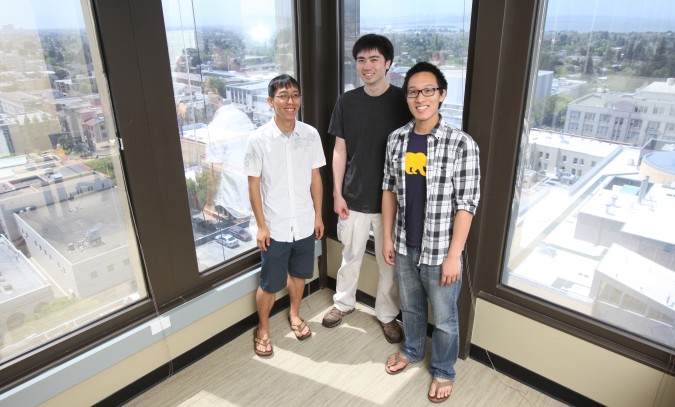
Timothy Liu, Brian Tang and Eliot Sun - three of the four co-founders of Kloudless, Inc., May 2, 2012. Photo by Kevin Warnock.
On Tuesday, May 2, 2012, I met with Eliot Sun, co-founder and CEO at Kloudless, Inc., winner of the IT and Web track at the 2012 Berkeley Startup Competition.
Sun and his three co-founders, Timothy Liu, Brian Tang and Vinod Chandru, have built an impressive productivity utility for use with Gmail, Google’s web based email service. I didn’t get to meet Chandru, which is why he’s not pictured here, as I took all of these pictures. Click on them to see them full size.
Liu, Tang and Sun allowed me to photograph them in their corner cubicle of the University of California Startup Accelerator @Skydeck, commonly referred to around campus as simply Skydeck. Have a look at the sweeping view in the photographs here. That’s San Francisco’s skyline directly behind the heads of Tang and Sun. Click the picture and wait for it to load in a new window. Then click the picture again to see the full size version. You can clearly see the San Francisco Bay Bridge through the glass window.
The Skydeck is located on the penthouse floor of the tallest building in Berkeley, at 2150 Shattuck Avenue, Berkeley, California USA. This building is at the the top of the escalator from the circular exit to the Berkeley BART station.
Kloudless is still in private beta, and I have not personally used the service. But Sun did give me a great demonstration of the working site.
Eliot Sun knew up front that I am a blogger and that I would write this post.
Kloudless is targeted towards users that receive a lot of email with important attachments. Emails that contain attachments fill up email storage far faster than emails without attachments. Search in Gmail does not look inside attachments, according to Sun.
What Kloudless does is hard to believe hasn’t been done before, as it’s brilliant.
Kloudless has a plugin for Gmail that modifies the user’s options. A new option when one receives an email with an attachment is to move the attachment to that user’s account at either DropBox or Box, which are popular cloud storage services offered by two different companies.
If a Kloudless user directs the service to move the attachment file to DropBox or Box, the Kloudless service does so. What makes Kloudless deserving of winning competitions is that it remembers where it put the file. The next time the user views that email in Gmail, they won’t have the attachment directly available to them from Google. However, there will be a link to the file that is now stored in the cloud at either Box or DropBox. A file can be stored at both services at once, if the user so chooses.
Kloudless is storing the association between original email and the stored attachment now in the cloud outside of Google.
There is a screen in Kloudless where users can review all their attachments in a view that omits all the emails that did not have attachments originally. This condensed view is compelling, for its brevity. If a user finds a file they are interested in, that user can click back to the original email message that brought the file to them in the first place.
There’s a lot to like about the Kloudless business model. They are not a cloud storage provider, so they avoid having to store petabytes of data. They’re storing metadata, not attachments. Their own hosting costs should be moderate since they still have to pay for the bandwidth to move files around between Google and the cloud storage providers.
Kloudless is likely to be able to charge for this service, because it gives such useful control and quick access to users.
Users that embrace Kloudless are likely to stay customers forever, because if they quit the service, presumably they will lose their ability to associate their attachments with their emails, which could be painful.
Eliot Sun is a smart guy. He holds degrees in Mathematics and Economics as well as minors in Chinese and Latin, all from UC Berkeley. You don’t frequently find engineers that seriously studied Latin.
Sun’s three co-founders Timothy Liu, Brian Tang and Vinod Chandru also all graduated from UC Berkeley. Liu is CTO, Tang is Chief Scientist and Chandru is Vice President of Engineering.
Sun also had the smarts to get his name as a domain name, which everyone should do if they can. There’s no better beach front real estate for your personal brand than your own name followed by .com.
Global Brain Corporation, a venture capital firm in Japan, invited Sun to attend their annual Global Brian Alliance Forum in December, 2011. Sun spent four days meeting with potential partners and one day at the Forum. Sun’s Kloudless presentation at the Forum was judged the best pitch of the event.
On September 22, 2011, Kloudless won first place in the Plug and Play EXPO at the Plug and Play Tech Center.
Including the IT and Web track at the Berkeley Startup Competition last month, that’s three wins in less than six months, and Kloudless hasn’t even launched yet.
Kloudless is a company to watch.
PS – I posted 16 more shots from my photoshoot with three of the four Kloudless co-founders to my Facebook profile, where you can subscribe to my updates. I had my studio lights with me as I was on my way to a photoshoot with model Annika, from my blog post about AlbertMing, an early adopter of Skydeck’s services that’s since moved to their own office space in Berkeley.
I met with startup advisor John Matthesen, mentor to HARBO Technologies in the 2012 UC Berkeley Startup Competition
I enjoy blogging.
I am enjoying it more all the time for it affords me the opportunity to sit down and talk with interesting people.
When I covered the Berkeley Startup Competition (prior to 2012 known as The Berkeley Business Plan Competition) on April 26, 2012, I introduced myself to John Matthesen. Matthesen was assigned this year to mentor HARBO Technologies, which won the Energy and Clean Tech (archived version for use if previous link breaks in the future — 2012 Berkeley Startup Competition winners list) track of the competition with its innovative system to greatly reduce the environmental impact of oil spills in bodies of water.
I met Matthesen while I was waiting in line to introduce myself to HARBO’s CEO Boaz Ur.
I told both Ur and Metthesen that I’d like to interview HARBO for my blog. Since HARBO has invented new technology, they’re not yet ready for press coverage, as they’re still working on the legal issues, Matthesen explained by email. But he said I could interview him individually so long as we didn’t discuss HARBO. Matthesen struck me as an interesting guy I should meet in any event, so I took him up on his offer.
I met John Matthesen for coffee at the trendy ZEB Cafe at the University of California Berkeley Law School at 2745 Bancroft Way, Berkeley, California USA. According to Matthesen’s website for his company Related Concepts, he helps companies with interim management, qualitative customer research, business process development, team building and coaching, and finally, board of directors / advisory boards. I confined my questions to his background and his work as a mentor.
We jumped around to a lot of topics, never really finding a theme for this post — it didn’t seem right to talk about the past companies he’s mentored for the Berkeley Startup Competition without getting the permission from those teams.
I do feel comfortable saying that two years ago Matthesen was mentor to the winner of the 2010 Products & Services Track, BrightSense, which, according the Berkeley competition’s website:
“… uses a novel patent-pending drug delivery technology to design customized whitening strips with peroxide dosages optimized for each user’s teeth.”
There is more information about BrightSense in the University of California 2010 Berkeley Business Plan Competition booklet.
Matthesen has been fortunate to advise two winning teams.
I asked Matthesen how he got to be asked to be a mentor in the Berkeley Startup Competition. He wasn’t sure, but speculated it had to do with his background at Sybase and Commerce One.
Matthesen was an early employee at Sybase, one of the early pioneers in the database market. Microsoft licensed Sybase to form the basis of Microsoft SQL Server, still Microsoft’s sole enterprise database product. Matthesen had worked in Information Technology role at a hotel in Hawaii, and the hours were brutal. The hours Sybase told its new hires they would be expected to work were long as well, but less intense that what he endured in Hawaii. Matthesen intended to stay at Sybase just 6 months, but instead stayed for 7 years, through their initial public offering of stock. Sybase today is owned by SAP.
After Sybase, Matthesen went to Commerce One, early enough to ride the first dot com boom up to its height, and for long enough to witness the carnage of the boom’s aftermath — another seven years.
After 14 years of intensity at Sybase and Commerce One, Matthesen was ready for a break, so he turned down an early job at Google, which sadly presumably cost him millions of dollars. Ouch!
I asked Mattesen if he knew David Henderson, but he didn’t. I hired Henderson to work with me for a little over a year at my first Internet company, Hotpaper.com, Inc., and his next job was at Commerce One.
While researching this post, I discovered that Commerce One is still in business, though it’s an invisible shadow of its former self. Congratulations to the team for staying in business given the turmoil along the way.
Matthesen entertained me with crazy stories of the stock price of Commerce One shooting past USD $1,000 per share and then collapsing to zero. Matthesen advised the Commerce One CEO to ‘buy something big’ of real value, but his advice was rebuffed. The companies Commerce One could have bought at the peak of its power as a public company are still large household names deeply embedded into the daily fabric of the planet.
Matthesen told me he managed his personal finances during that crazy boom time such that he could pay his Alternative Minimum Tax bill, when his colleagues and friends were going bankrupt over their huge AMT bills in the many millions of dollars.
Young entrepreneurs in today’s boom may not be familiar with how unfair United States tax policy was during the first boom. If one exercised stock options but didn’t sell the stock right away, there was a big risk that the stock would go down by the time you sold the stock. The AMT tax was applied to the paper gain you made when you exercised the stock, and if the stock collapsed before you could sell it, you still owed tax on the paper gain. Think of the devastation if you had a USD $100,000,000 paper gain and the stock dropped to zero before you sold it. You would owe AMT tax on the $100,000,000 even though you never touched the cash.
I haven’t paid much attention recently to this AMT trap, and I never got caught in it when I sold Hotpaper, as I never held options, just common stock.
I learned from Matthesen that the AMT trap in 2009 was partly fixed, retroactively. People who were ensnared in the early 2000s were able to apply for relief and get huge sums back from the United States Treasury.
I don’t want to take on the responsibility to accurately summarize the tax relief, so I direct you to this article on the subject.
I spoke with Matthesen for less than an hour, and mostly we shared war stories. After I interview Boaz Ur of HARBO, I’ll likely have more to say. Until then, have a look at the pictures I took of Matthesen at the conclusion of our conversation, above.
